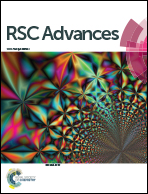Role of functional groups on protonated de-oiled soybean involved in triclosan biosorption from aqueous solution†
Abstract
Protonated de-oiled soybean (PDOS) as a low-cost and effective biosorbent was used for the biosorption of triclosan (TCS) from aqueous solution. The contribution of functional groups such as amine, carboxyl, sulfhydryl, phosphate and lipids on PDOS to TCS biosorption was evaluated by means of chemical modification. The results showed that sulfhydryl groups gave the largest contribution, followed by lipids and amine groups, while the contribution of carboxyl groups could not be confirmed. FTIR spectra offered help to identify the introduced functional group changes. Based on the results, it was proposed that the TCS biosorption onto PDOS was determined by hydrophobic interaction and hydrogen bonding rather than electrostatic interaction. The TCS biosorption process depended much on initial pH and the optimum pH value was 4.0. Kinetic studies demonstrated that a pseudo-second-order model was more applicable for description of the biosorption of TCS onto PDOS; both intra-particle diffusion and boundary layer diffusion might affect the biosorption rate. The Dubinnin–Radushkevich (D–R) isotherm agreed well with the biosorption equilibrium data over the whole concentration range, and the maximum biosorption capacity was 124.55 mg g−1, revealing that biosorption via PDOS could be used as an effective method for TCS removal from aqueous solution.


 Please wait while we load your content...
Please wait while we load your content...